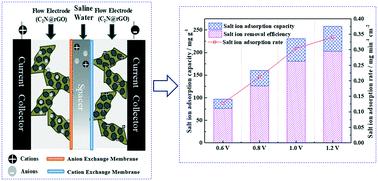当前位置:
X-MOL 学术
›
Environ. Sci.: Nano
›
论文详情
Our official English website, www.x-mol.net, welcomes your
feedback! (Note: you will need to create a separate account there.)
Nanoarchitectured reduced graphene oxide composite C2N materials as flow electrodes to optimize desalination performance
Environmental Science: Nano ( IF 5.8 ) Pub Date : 2020-05-23 , DOI: 10.1039/d0en00249f Danping Li 1, 2, 3, 4, 5 , Xun-An Ning 1, 2, 3, 4, 5 , Yang Li 1, 2, 3, 4, 5 , Jianpei Zhang 1, 2, 3, 4, 5
Environmental Science: Nano ( IF 5.8 ) Pub Date : 2020-05-23 , DOI: 10.1039/d0en00249f Danping Li 1, 2, 3, 4, 5 , Xun-An Ning 1, 2, 3, 4, 5 , Yang Li 1, 2, 3, 4, 5 , Jianpei Zhang 1, 2, 3, 4, 5
Affiliation

|
Flow electrode capacitive deionization (FCDI) utilizes flowable electrodes to obtain a continuous and extensible desalination approach, eliminating the discharging step. However, the poor conductivity of flow electrode slurry and high clogging risk during the desalting process can limit desalination performance. Thus, we prepare the C2N@rGO material as a flow electrode to solve the channel blocking problem and improve the salt ion removal performance, maximizing the amount of active particles that can be added to the deionization process by forming a conductive network. The as-synthetized material possesses a large specific surface area, rich micropores, high N-doping, and tunable graphitization structure, which can further enhance the desalination properties of the as-prepared electrode. The results indicate that C2N@rGO-4% has an optimal porous structure (812.3 m2 g−1) and chemical composition (29.5%, N-doping), and the highest specific capacitance (236.6 F g−1). The FCDI results reveal that C2N@rGO-4% has a high salt ion adsorption capacity (180.72 mg g−1), salt ion adsorption rate (0.3043 mg min−1 cm2), salt ion removal efficiency (49.93%), and current efficiency (65.22%) under a 1.81 g L−1 NaCl solution at 1.0 V. Moreover, the results also indicate that the FCDI performance partly relies on the synergistic effect between the porous structure and chemical composition. Therefore, as an electrode material, C2N@rGO has strong potential for application in FCDI systems.
中文翻译:

纳米结构还原氧化石墨烯复合C2N材料作为流动电极以优化脱盐性能
流动电极电容去离子(FCDI)利用可流动电极获得连续且可扩展的脱盐方法,从而省去了放电步骤。然而,在脱盐过程中,流动电极浆料的电导率差以及高堵塞风险会限制脱盐性能。因此,我们准备C 2N @ rGO材料用作流动电极,可解决通道阻塞问题并提高盐离子去除性能,从而通过形成导电网络最大程度地增加可加入去离子工艺的活性颗粒数量。合成后的材料具有较大的比表面积,丰富的微孔,高的N掺杂和可调节的石墨化结构,这可以进一步增强所制备电极的脱盐性能。结果表明,C 2 N @ rGO-4%具有最佳的多孔结构(812.3 m 2 g -1)和化学成分(29.5%,N掺杂),具有最高的比电容(236.6 F g -1)。FCDI结果表明,C 2N @ rGO-4%具有较高的盐离子吸附能力(180.72 mg g -1),盐离子吸附率(0.3043 mg min -1 cm 2),盐离子去除效率(49.93%)和电流效率(65.22%) )在1.01 V的1.81 g L -1 NaCl溶液中。此外,结果还表明FCDI性能部分取决于多孔结构与化学组成之间的协同效应。因此,作为电极材料,C 2 N @ rGO具有在FCDI系统中应用的强大潜力。
更新日期:2020-07-16
中文翻译:

纳米结构还原氧化石墨烯复合C2N材料作为流动电极以优化脱盐性能
流动电极电容去离子(FCDI)利用可流动电极获得连续且可扩展的脱盐方法,从而省去了放电步骤。然而,在脱盐过程中,流动电极浆料的电导率差以及高堵塞风险会限制脱盐性能。因此,我们准备C 2N @ rGO材料用作流动电极,可解决通道阻塞问题并提高盐离子去除性能,从而通过形成导电网络最大程度地增加可加入去离子工艺的活性颗粒数量。合成后的材料具有较大的比表面积,丰富的微孔,高的N掺杂和可调节的石墨化结构,这可以进一步增强所制备电极的脱盐性能。结果表明,C 2 N @ rGO-4%具有最佳的多孔结构(812.3 m 2 g -1)和化学成分(29.5%,N掺杂),具有最高的比电容(236.6 F g -1)。FCDI结果表明,C 2N @ rGO-4%具有较高的盐离子吸附能力(180.72 mg g -1),盐离子吸附率(0.3043 mg min -1 cm 2),盐离子去除效率(49.93%)和电流效率(65.22%) )在1.01 V的1.81 g L -1 NaCl溶液中。此外,结果还表明FCDI性能部分取决于多孔结构与化学组成之间的协同效应。因此,作为电极材料,C 2 N @ rGO具有在FCDI系统中应用的强大潜力。











































 京公网安备 11010802027423号
京公网安备 11010802027423号